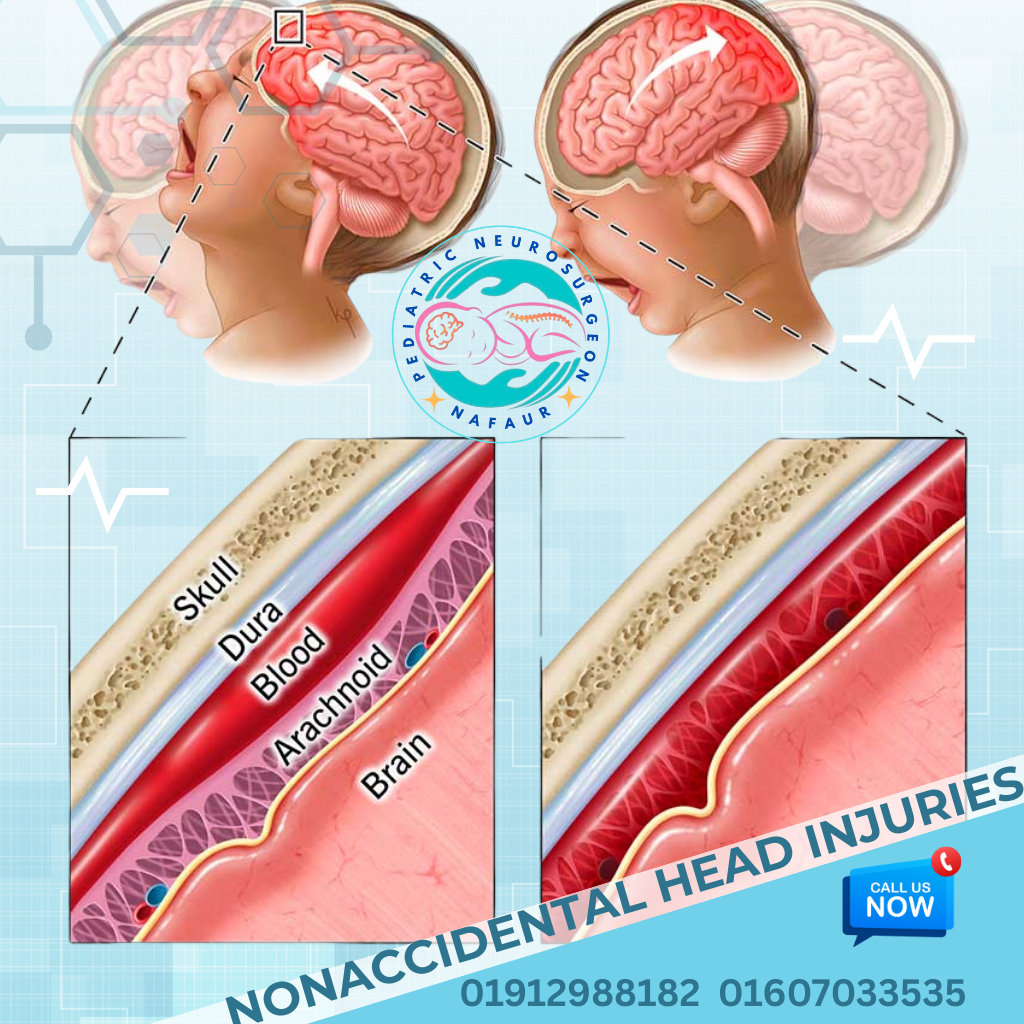Nonaccidental Head injuries
Nonaccidental Head Injuries
Pediatric Nonaccidental Head Injuries (NAHI)—also known as abusive head trauma (AHT)—refer to brain injuries in infants and young children that occur due to intentional or inflicted harm, such as shaking, blunt trauma, or impact-related abuse. These injuries are not caused by falls, accidents, or medical conditions, and often occur in vulnerable children under the age of 2. In Bangladesh, nonaccidental injuries in children are often underreported, misdiagnosed, or ignored due to sociocultural taboos, lack of awareness, and inadequate legal and medical collaboration. Dr. Md. Nafaur Rahman, with his extensive experience in pediatric neurosurgery, plays a vital role in early detection, urgent surgical management, and child protection referrals, helping safeguard children's lives and rights. 🚨 Types of Nonaccidental Head Injuries Nonaccidental head trauma may present in various forms: Common Forms of NAHI: Shaken Baby Syndrome – Caused by violent shaking, leading to subdural hemorrhage and retinal bleeding Blunt Force Injury – From slapping, punching, or hitting with an object Skull Fractures – Linear, depressed, or complex fractures inconsistent with history Subdural and Subarachnoid Hemorrhages Diffuse Axonal Injury (DAI) – Widespread brain damage from rotational trauma Cerebral Edema – Swelling of the brain, often fatal without urgent care Diffuse Axonal Injury (DAI) – From delayed or impaired blood flow after trauma These injuries may lead to permanent neurological disability, developmental delay, blindness, or death if not promptly managed. ⚠️ Warning Signs of Nonaccidental Trauma Pediatric NAHI may present subtly or as a life-threatening emergency. Caregivers and medical professionals must watch for: Seizures or unconsciousness in infants without explanation Bulging fontanelle (soft spot) or enlarged head circumference Recurrent vomiting or irritability Poor feeding and lethargy Bruises on scalp, face, or neck Inconsistent history or delay in seeking treatment Previous injury marks or multiple healing fractures In Bangladesh, these signs may be explained away as “evil eye,” “fall from bed,” or “malnutrition,” leading to delayed neurosurgical intervention and legal oversight. 🧠 Diagnosis and Evaluation of NAHI Early and accurate diagnosis of abusive head trauma is essential—not only for saving the child’s life but also for initiating protective action. Diagnostic Protocol at Dr. Nafaur Rahman’s Center: Emergency Neuroimaging (CT/MRI Brain) – Identifies hemorrhage, skull fractures, cerebral edema Skeletal Survey/X-ray – Detects old or healing fractures suggestive of repeated abuse Fundoscopy – To look for retinal hemorrhages, a key indicator of abuse Neurosonography – In infants with open fontanelle Blood tests – To rule out clotting disorders that mimic bleeding Multidisciplinary Case Review – With pediatricians, child psychologists, and legal authorities All assessments are carried out with utmost sensitivity and privacy at NINS and Bangladesh Paediatric Neurocare Centre, under Dr. Nafaur’s supervision. 🛠️ Neurosurgical Management of NAHI Many cases of NAHI require emergency neurosurgical intervention to prevent death or irreversible brain damage. Dr. Md. Nafaur Rahman specializes in performing life-saving procedures for children affected by abusive trauma. Surgical Options Include: Evacuation of Subdural Hematoma – To relieve pressure on the brain Decompressive Craniectomy – To control swelling in cases of severe cerebral edema Cranioplasty – Later performed for reconstruction if bone flap is removed Ventriculoperitoneal (VP) Shunting – For hydrocephalus resulting from injury Intracranial Pressure Monitoring – In severe head injury cases “Every case of abusive head trauma is a silent cry for help. As neurosurgeons, we don’t just save brains—we help protect futures.” — Dr. Md. Nafaur Rahman 🧬 Long-Term Outcomes and Support Children who survive NAHI often require long-term rehabilitation and support due to: Cognitive impairment or developmental delay Epilepsy or spasticity Vision or hearing loss Behavioral disorders or autism spectrum manifestations Rehabilitation Services Offered: Neurodevelopmental therapy Speech and occupational therapy Behavioral counseling Parental training and caregiver support Referral to child protection and legal services 🌍 Nonaccidental Head Injuries in Bangladesh: Challenges and Solutions Ground Realities: Stigma and denial surrounding child abuse Lack of standardized reporting system for NAHI Fear of legal action prevents caregivers from revealing truth Few trained pediatric neurosurgeons with expertise in forensic evaluation Dr. Nafaur Rahman’s Contributions: Works closely with pediatricians, legal teams, and social services to report suspected abuse Provides confidential consultations and documentation Offers expert medico-legal reports required for child safety Educates general physicians and ER staff in early detection of abusive head trauma 👨⚕️ Why Trust Dr. Md. Nafaur Rahman? 🧠 One of Bangladesh’s few neurosurgeons trained in pediatric forensic head trauma 🏥 Operates at NINS, a national referral hospital for complex pediatric cases 🧒 Passionate about protecting vulnerable children from abuse and neglect 🔍 Combines clinical skill with legal sensitivity and ethical reporting 🤝 Collaborates with multidisciplinary child protection teams across Bangladesh 📞 Contact for Confidential Pediatric Head Injury Assessment Dr. Md. Nafaur Rahman Assistant Professor, Pediatric Neurosurgery, NINS Chief Consultant, Bangladesh Paediatric Neurocare Centre 📱 For Appointment (Confidential): 01912988182 | 01607033535 🌐 Website: www.neurosurgeonnafaur.com
Nonaccidental Head Injuries










